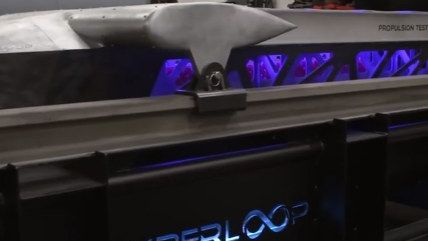We've Got Initial Hyperloop Testing—and Competition!
No tubes yet, but they're coming.

We have real world, not-just-theoretical Hyperloop action! Yesterday, out in the Nevada desert, Hyperloop One (formerly Hyperloop Technologies) gave its first public test of a very early iteration of the technology it will be using to create its version of the Elon Musk-inspired mass transit system.
The Hyperloop (for those who have not been paying attention) was conceptualized by Musk back in 2013 as a way to use pressurized tubes to transport cargo and people long distances at extremely high speeds—more than 700 miles per hour. Musk drew part of his inspiration from a desire to create a more efficient, faster, and cheaper version of California's proposed completely subsidized high-speed rail, Gov. Jerry Brown's pet boondoggle with out-of-control costs.
Musk is not actually building the Hyperloop himself. He set the idea free and startups have taken on the task of trying to actually make the thing real (and securing private funding to do so—something California hasn't been able to manage with its train).
Hyperloop One brought media out to see its test of an open track yesterday. Though apparently the open track can reportedly reach speeds of 400 miles per hour, CNN noted that this test yesterday hit only 116 miles per hour. But it did so in less than two seconds:
They are building the actual tubes right now (you can see pictures at their site) and are hoping to have a 1.5-kilometer enclosed test track operational by the end of the year. Hyperloop One hopes to be moving cargo by 2019 and people by 2021.
But Hyperloop One is not the only people out there seriously working on making this theoretical project real. There's also Hyperloop Transport Technologies, and on Monday they revealed information about the technology they're advancing. They're going to be approaching propulsion through a variation on the familiar magnetic levitation technology, or MAGLEV. Magnetic levitation is already used for some high-speed rail systems, and it's extremely expensive. Hyperloop Technologies wants to take a different spin on the technology via a "passive" levitation system that would put its magnetic systems on the travel pods themselves rather than down the entire track. They believe this would significantly reduce infrastructure costs. Here's an explanatory video from them:
Hyperloop Transport Technologies announced in March they had entered into an agreement to bring their technology to Slovakia to build a track. They're hoping to connect it later to Austria and Hungary. Hyperloop Tranpsort Technologies CEO Dirk Ahlborn said they also planned to break ground this year on a test track in Quay Valley, California, and was hoping to transport customers by 2019. Reason interviewed Ahlborn about his plans back in 2015. Watch below:
While we have no idea whether these transportation methods will prove to be viable, it's interesting to watch this all develop without direct government subsidies so far. However, Hyperloop One is attempting to land tax credits and incentives worth millions in Las Vegas. We also don't know what the future could entail, should the tests prove successful. A proposed high-speed rail line from Los Angeles to Las Vegas was originally marketed as being privately funded, but then later they started seeking out government loans.


Show Comments (59)